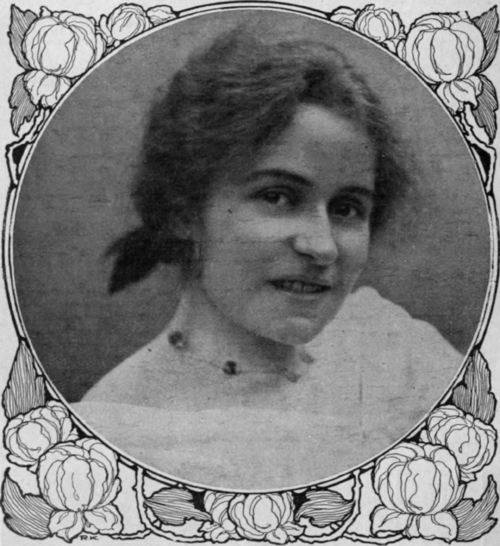6. The Triumph Of Woman
Description
This section is from "Every Woman's Encyclopaedia". Also available from Amazon: Every Woman's Encyclopaedia.
6. The Triumph Of Woman

By Sarah A. Tooley
Women and Temperance - A New Idea in Club Organisation - Women's Clubs - The Co-operative Movement - Industrial Unions and Councils - The Breaking Down of Barriers - A Woman Refuter of a Great Theologian - Eve's Claim to the Apple - The New Eve and Her Garden - Women as Horticulturists and Farmers - Some Pioneers - Training Colleges and Institutions - Women Architects
If we pass to the question of temperance, again we find women splendidly organised throughout the world by means of the World's Women's Christian Temperance Union, and working shoulder to shoulder on international lines. The late Miss Frances

Miss Constance Smedley (Mrs. Maxwell Armfield), founder of the Lyceum Club, which now has affiliated branches in several of the capital cities of the world
Willard, of the United States, will be remembered as the eloquent advocate, in conjunction with Lady Henry Somerset, for the federating of British temperance women to this great organisation. It had its origin in the United States, and works not only in the cause of temperance, but of social purity, woman suffrage, and for the general advancement of women. It has no fewer than thirty-five departments of work, nine round-the-world missionaries, and fifty-five affiliated countries. The president is the
Countess Of Carlisle
Women have also introduced the international idea into club life. Miss Constance Smedley (now Mrs. Maxwell Armfield) founded the Lyceum Club, Piccadilly, in 1904, with the intention of forming a union of women engaged in artistic and intellectual pursuits in the various countries of the world, and by the establishment and affiliation of club centres to promote interchange of thought between the cultured women of all nations.
Miss Smedley conceived the magnificent idea of founding Lyceum Clubs in each capital city of Europe, and in the chief centres of America, Canada. Australia, India, and the other colonies, each having its own committee of management, but united in aim. A member of one club is virtually a member of all clubs in this embracing scheme. So far Lyceum Clubs have been established in Berlin, Paris, Berne, and New York.
It is a very illuminating fact that women, who a decade or two ago were held to be hopelessly unclubbable, should be the movers in founding a club system to encircle the globe.
Indeed, the rapid development of women's clubs is a remarkable feature of the day, and illustrates the increasing disposition of women to combine for mutual convenience, recreation, and interchange of ideas in the more public form of social life.
In 1884, the Alexandra, the first club founded exclusively for ladies, opened its doors - rather "timidly," shall we say? - in the heart of Mayfair, as a quiet, social centre where refinement and homeliness were combined, and an unmarried girl might stay with her maid, unaccompanied by a chaperone. There was no smoking-room, and males above the age of seven were not admitted as guests. It became a tradition amongst the ladies of county families to belong to the Alexandra, a club as sweet and gracious in its womanly environment as the Royal lady whose name it bears. Other social clubs followed.
The Pioneer Club
Then came a demand for a woman's club which should draw together women engaged in public and professional work, or connected with social and philanthropic work, and that noble-spirited woman the late Mrs. Massing-berd founded the Pioneer Club in 1892, with the inspiring motto:
We the route for travel clearing,
Pioneers, O Pioneers! All the hands of comrades clasping,
Pioneers, O Pioneers!"
The outside public was prone to regard it somewhat dubiously, at that period, as a stronghold of feminism, and it is certain that its original membership included some of the most advanced and earnest-spirited women of the day, whose names were allied with woman suffrage, temperance, social purity, vegetarianism, anti-vivisection, anti-vaccination, as well as those distinguished in art and literature. All shared the sublime philosophy of the adage:
They say! What do they say? Let them say!
Since these earlier clubs opened their doors, the movement has spread, until now the woman who has not a club is becoming the exception. There are upwards of thirty women's clubs in London, with an aggregate membership of over twenty thousand. There are also several mixed clubs where women are members. Whether a woman be rich or poor, aristocratic or democratic, learned or frivolous, smart or dowdy, strong-minded or frankly weak, religious, political, philanthropic, domestic, literary, artistic, musical, or simply social, she can find a club to suit her tastes, temperament, and pocket.
There has been a great increase of freedom and luxury in women's clubs. The earliest ones were distinguished by refined but unostentatious appointments and had strict rules. Each new club now seems to vie with its predecessors in luxury.
At first gentlemen guests were received tentatively, and the smoking-room was not "talked about." Now, with rare exceptions, every woman's club welcomes gentlemen as visitors, and provides a commodious smoking-room for its members.
Co-Operative Movements
Whether this startling increase of club life amongst the upper and middle classes of women is at the root of the supposed decay of home life is a debatable question for the sociologist. Two causes undoubtedly contribute to the popularity of clubs for women - the strain and stress of battling with the noise and danger of London traffic, which drives a woman after a shopping expedition to the rest room of the club, and the increasing spirit of camaraderie amongst women, which induces them to seek fellowship with each other. In her private home life a woman may be almost cut off from the companionship of anyone sharing her ideals, but at her chosen club she is sure of meeting kindred spirits.
Continue to:


